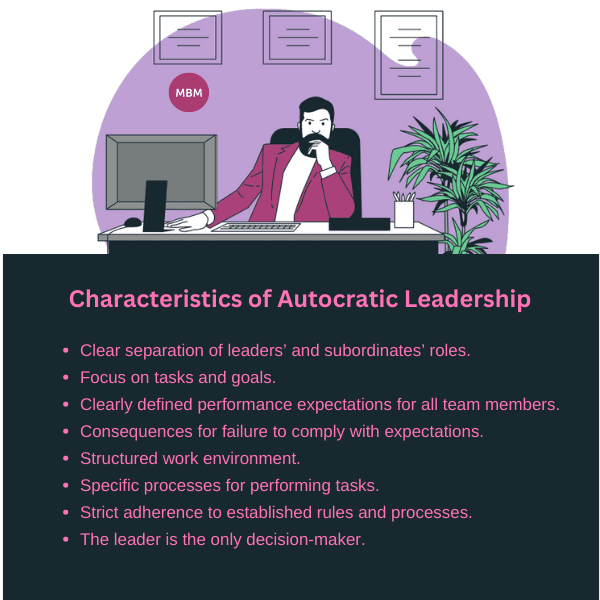How to Lead From the Top and Bring People With You
Autocratic leadership is a style of leadership characterised by direct, top-down communication and commands.
In the Western world, the democratic movements of the last two centuries have led to expectations of increasing participation in political decision-making in everyday life. As a result, people tend to view autocratic leadership rather sceptically, citing conspicuous examples like Putin, and criticise it for keeping subordinates away from power.
In this article we explore what autocratic leadership means in 2023, and where and when it’s appropriate and effective in a business setting. As we’ll see, the way people see and use autocratic leadership has changed over the years.
Provided employees are properly rewarded and fairly treated, and their welfare’s supported, autocratic leadership can prove very effective in setting the vision, making decisions, establishing clear processes, motivating people, and getting results.
What is Meant by Autocratic Leadership?
Autocratic leadership is the concentration of decision-making and power in only one person, who takes little or no input from others. There’s a clearly defined boss at the top, holding most of, or all, the control over allocating work and responsibility.

A central part of autocratic leadership is the leader having a clear vision of what they want the business to do, and where they want it to go. Which is obviously a good thing. But for the best results, you need to bring your people with you and inspire them.
A common criticism of autocratic leadership as an everyday style for managing teams in ‘normal’ circumstances is that it can diminish recognition of employees’ achievements. Unchecked, morale can suffer to the point where it can endanger group stability and people leave.
If you decide autocratic leadership is the right approach for your business, you need to be self-aware and accompany it with a strong reward and benefits structure, empathy, clear and positive feedback, fairness, and connection with your people. We’ll come back to this.
Where Does Autocratic Leadership Fit in With Other Leadership Styles?
Autocratic leadership, AKA authoritative leadership, is one of the three leadership styles the German American psychologist Dr Kurt Lewin identified in 1939:
- Autocratic
- Democratic
- Laissez-faire
In managing work teams, these leadership styles show themselves as follows:
Autocratic:
Deliver streamlined work that improves efficiency and productivity. They set firm deadlines and have clear expectations. In Lewin’s definition, autocratic leaders make decisions without consulting team members, even if their input would be useful. This can be problematic.
Sticky Learning ® is 7 times more effective than 1-day training courses. Plus, you will get a Chain of Evidence proving your Return on Investment. Discover soft skills training that changes behaviours long term.

Democratic:
Encourages free exchange of ideas among the team and relies on every member contributing. Each team member shares the freedoms and responsibilities of leadership to an extent.
Laissez-faire:
Leaders assign work and general direction but aren’t involved in day-to-day tasks. Laissez-faire leaders put much faith in the individual, and trust people to remain self-motivated, on-task, and personally accountable.

What is Autocratic Leadership Best for?
Autocratic leaders make choices and decisions based on their own beliefs, and as we’ve said, don’t involve others in decisions or look to them for advice. The leader has sole responsibility for the decision and the outcome.
The downside is, autocratic leaders can seem to their subordinates to have a limited perspective and aren’t open to other ideas. They don’t trust their teams to deliver excellence on their own. As a result, people can feel micromanaged, undervalued, and resentful. That said, autocratic leadership can be useful.
Start-ups and Small Companies:
This kind of leadership is often seen in start-ups and small companies with few employees. It’s highly effective when the nature of the work needs quick decision-making. Autocratic leadership is a valid leadership style for regaining control in a crisis and getting things back on track. It creates fewer misunderstandings and possible wrong directions.
Experiencing Hard Times:
As we saw in the pandemic, this style can be necessary in hard times, to make sure everyone knuckles down and works hard towards the company goals. As the pressure eases, you can afford to relax and adopt a less authoritative approach, and change focus, from maintaining day-to-day continuity to fulfilling the business’s potential.
Faced with today’s talent shortage, business leaders need to retain good people and engage them. So, autocratic leadership must be tempered with self-awareness and respect. Top-down communication must be balanced with constructive feedback, fairness, and compassion.
Where There is Inspiration:
Another area where autocratic leadership is beneficial is when people are doing great work and reap the rewards. Where employees need direction and vision, it encourages high-quality output. Employees will happily follow autocratic leaders when they feel inspired and trust them to guide them towards success.
Autocratic leaders approach projects and change initiatives from a position of confidence. They have a clear vision of what success looks like and give their team members clear direction and constructive feedback as they work towards their goals.
What Are the 3 Types of Autocratic Leadership?
Autocratic leadership can show itself in different ways but it isn’t completely rigid. Different situations will influence how the business and the leader implement the style. But we’ll come back to this. Commentators identify three types of autocratic leadership:

‘Directing’ is the commonest and most inflexible form of autocratic leadership style. Subordinates are closely monitored, as we’ve said from the start, and the leader isn’t likely to consult them in decision-making.
‘Permissive’ is a somewhat more open type of autocratic leadership. The leader still has charge of making the final decision. But their subordinates have some flexibility in deciding how to perform their tasks, so it’s closer to democratic leadership.
‘Paternalistic’ autocratic leadership uses the same core characteristics of authoritarian leadership. The difference is that it balances these with concern over the well-being and happiness of the subordinates.
As the word ’paternalistic’ suggests, this can be where the leader sees their function as parental. So if employees aren’t feeling up to the challenge, things can go wrong. In this kind of authoritative leadership, the decisions are made with the emotional well-being of the people performing the tasks, as well as the operational goals.
While we’re here, paternalistic autocratic leadership overlaps with paternalistic leadership, where the parental leader guides and protects their subordinates as members of their family. They provide them with good working conditions and fringe benefits. It’s fine in some cultures. But not all.
Democratic Leadership – How Does It Fit With Autocratic Leadership?
As we’ve said, autocratic leadership is highly effective if you’re leading a work group carrying out routine work, and need to reach certain output levels. You’re responsible as the leader, for achieving the goal. Moreover, the priority is carrying out the task on time to the desired standard.
Leading a team of more qualified and experienced individuals, or heading up a leadership team is a different scenario. You’re still responsible for achieving results, but it involves co-creation, Stephen R. Covey’s 7th Habit of Highly Effective People.
In democratic leadership, your rank and title alone aren’t enough to give you authority over competent and experienced colleagues. To bring them with you, you need to earn their respect through empathy, persuasion, example, and performance.
That’s fine in normal times when the priority is agreeing on the direction with their colleagues, and shaping the strategy, then letting people get on with it. But when the business’s day-to-day continuity is a top priority, there’s a case for more autocratic leadership.
What Are the Characteristics of Autocratic Leadership?

For autocratic leadership to work, it needs a strong reward structure. It feels rather rigid, so it needs the right balance of benefits to keep people motivated. These benefits are likely to be money and other advantages, compensating for the lack of ability to make decisions or participate in leadership.
What Are the Advantages of Autocratic Leadership?
- Faster decision-making.
- Easier goal setting.
- Increased efficiency.
- Clarity in the line of efficiency.
- Obvious path-setting.
- Clear workplace expectations.
- Greater clarity all around.
- Provide direction and vision.
- Lead inexperienced workers.
- Breed goodwill.
- Clear leadership chain.
To keep their team on their side, autocratic leaders must approach them from a position of empathy. By understanding their personal ambitions, emotions, desires and worries, they will identify potential obstacles to progress, while rewarding success.
What Are the Disadvantages of Autocratic Leaders?
- Can appear overbearing and cause worker resentment.
- Don’t own their mistakes.
- Seen as bosses, not leaders.
- Little or no flexibility.
- Micromanaging.
- Discourage original thinking.
- Might affect work culture negatively.
- Leaders can face personal pressure and possible burnout.
Take a Wide-angle View of Autocratic Leadership

Our thinking around autocratic leadership has developed over time. Lewin coined the term autocratic leadership in 1939, though the idea existed before that. Classical management theory was popular in the early 20th century but goes back to ancient times.
It took an assembly-line view of the workplace and maintained that consulting groups of subordinates was unnecessary. Instead, the boss makes all the decisions and conveys them top-down for everyone to follow, which is autocratic leadership.
Lewin saw his leadership styles as distinct from each other and fixed. Since then, prominent thinkers have come to view them as more of a continuum. This may be to do with the growth in understanding in recent decades that various mental conditions are on a continuum in how they present in different individuals.
Ideas Continued to Build Over the Years…
20 years after Lewin Identified his leadership styles, Robert K. Tannenbaum and Warren H. Schmidt developed their continuum model of leadership in a paper published in the Harvard Business Review, in 1958.
They placed Lewin’s leadership styles at different points on the continuum in terms of the relationship between the level of freedom you choose to give employees, and the level of authority you exert when managing them.
“Giving autonomy” – laissez-faire leadership – is at one end. “Taking control”- autocratic leadership – is at the other.
The social psychologist Douglas McGregor, who was working in the 50s and 60s, was a further influence on Tannenbaum and Schmidt. McGregor came up with two contrasting motivation models. Theory X and Theory Y.
Theory X assumes people dislike work. They want to avoid it and take responsibility unwillingly. Theory Y considers that people are self-motivated and happily take responsibility.
Leaders who favour Theory Y are more likely to give their subordinates a chance when it comes to decision-making. But if the team members let them down, they should expect the boss to revert to Theory X and be authoritative, taking back control.
The ideas behind today’s modern management theory were formulated a few years later, in the 1960s. Modern management theory’s goal is maximising productivity, like classical management theory. However, it puts importance on doing so with empathy and creating a rewarding employee experience.
A New Continuum Was Suggested…
When Tannenbaum & Schmidt revisited their Continuum theory in the Harvard Business Review 1973, after further consideration, they suggested a new continuum of patterns of leadership behaviour.
In this, the area of freedom between managers and non-managers is constantly redefined by interactions between them and external forces acting on the business. The pattern was more complex compared to the previous one Tannenbaum & Schmidt identified, and they concluded that successful leaders know which behaviour is the most appropriate at a particular time.
There’s still a place for autocratic leadership, and people will accept it if they recognise and appreciate it’s what’s needed in the circumstances.
Famous Examples of Autocratic Leaders
Looking at the following famous examples people mention, it’s easy to see how autocratic leadership can be seen as a ‘bad’ thing, but it’s often key to achieving creative excellence:
- Henry VIII
- Margaret Thatcher
- Richard Nixon
- Queen Elizabeth 1
- Napoleon Bonaparte
- Vladimir Putin
- Donald Trump
- Tom Petty
- Glen Frey of the Eagles
- Ridley Scott
So think about the single-minded people you admire, in business or other fields. If they appear to be autocratic, how do they leverage it to keep people on their side?
There Are Cultural Differences in Accepting Autocratic Leadership
Some cultures are more accepting of autocratic leadership than others, which can complicate leading global teams. We mentioned paternalistic autocratic leadership overlapping with paternalistic leadership, with the parental leader guiding and protecting their subordinates as members of their family. This is fine in some cultures. But often, mature adult employees can resent being looked after like this.
Must-have Qualities and Skills You Need to Be an Autocratic Leader
If you decide your situation needs you to be an autocratic leader, you will need the following characteristics:
- Expertise
- Drive for perfection and results.
- Responsibility and accountability
- Consistency in what you do, including in rewards: treat everyone the same.
- Clarity in everything.
How to Get Your Team on Board With Autocratic Leadership
- Show respect and fairness to everyone.
- Create a sense of communication and explanation, including about changes before they happen.
- Allow different opinions.
One can characterise autocratic leadership by direct, top-down communication and commands. However, it doesn’t have to mean your people can’t express themselves, voice concerns or ask questions. You don’t have to listen to their suggestions when you implement changes, but allowing them to voice them adds a sense of freedom to the workplace.
In fact, experts say Bill Gates followed authoritative leadership as CEO of Microsoft, but encouraged participation and gave room for feedback in critical areas. Leverage your authoritative leadership like this, but make it clear that the decision to implement people’s ideas is in your hands. You’re in charge!
Action: For even more useful content on leadership, check out our ultimate guide on Leadership Skills.




